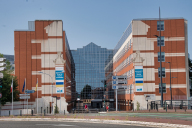Robert Venturi & Denise Scott Brown - Hôtel du Département Haute-Garonne, Toulouse (95/118)
To listen to more of Robert Venturi’s & Denise Scott Brown’s stories, go to the playlist: https://www.youtube.com/playlist?list=PLVV0r6CmEsFydP8aUVMUeqCjaBZimK7jg Internationally renowned architects Robert Venturi (1925-2018) and Denise Scott Brown (b. 1931) have helped transform contemporary design through their innovative architecture and planning, winning numerous prestigious awards for their work along the way. [Listener: Thomas Hughes] TRANSCRIPT: RV] Toulouse, again where the client… and we, in the end got along well. We were able to do a lot of what we were able to do, while a very big building. We were able to do a building with a way through it. We were able to do a building that fits beautifully with its context of Toulouse – which is one of our most favourite cities. It’s a red brick city, with a beautiful aura. We were able to do a building that had explicit ornament on the surfaces. We were able to do a building that had… that had symbolic elements, especially the two columns or representations of columns on the front. We were having to do a building that had wonderful restaurants in the neighbourhood, where we could have lunch. And as I said a while back, maybe we went back there a few weeks ago after six or seven years and it was so heavenly to say, it is still wonderful, it is being beautifully maintained, inside and out. And we talked to the clients’ users and they seemed to love it and that’s the reason they maintain it. And so, we were extremely happy… [DSB] The building… [RV] Made us very happy. [DSB] The building sits on a cleared site – the site was cleared when we found it and large. And on one side is an old arterial called Avenue Serres and then there’s a bridge on that Avenue and it is over the canal called the Canal du Midi, which comes in a great curve around the other site. And the site sits between those and then some small streets on the other sides. And between the bridge and the end of the site, we put this way, which in fact linked a commercial district on the one side of the bridge and a new commercial district beyond the site. So, we made a way between those two. And then, we put our administrative buildings on either side of that way and then there was a park on the canal side and a little square facing on to the old Avenue Serres, where the assembly hall was. So, the ceremonial buildings of this – it’s like a state capital, this building – Hôtel du Département and the Département is like a state and this one was called the Haute-Garonne. And Monsieur le President was our client which is the president of the state – the Département of the Haute-Garonne. [RV] Equivalent of a governor. [DSB] And they were pulling together all these regional offices and putting them in the one place and the reason was decentralisation in Paris. So, France was becoming a less centralised nation giving some governmental functions – more governmental functions – to the départements and now, they will once again. So, we had to hold, I think, it was 1400 workers and now there’s going to be 5000 there. And so, it’s a really big building and the public came there to pay their taxes and various businesses that they had to do with departmental government. And then, the deputies came there to vote, so, a wonderful combination. They also wanted a day-care shelter there and this park, and so on. And a big restaurant for the deputies, another one for the staff. It was a socialist government. American music and all the radios of the labourers as they worked, it was funny. But, so, many people would have taken that site and say, ‘We could put a slab here and another slab here, and another slab there’. Starting as Urbanists, we start with the city builder, the movement system – that’s one of the functions of the movement system, it builds cities. So, there’s our city builder, then our buildings on either side. Having the whole divided basically in two and then with a ceremonial addendum, you know… addition to it… allowed us to keep the buildings low. And the area in Toulouse where we built was not the center, not the sacred historic downtown, which is exquisite with red brick, even red brick cathedrals. And here, it was… [RV] Just one cathedral. [DSB] One cathedral and other churches. And here the buildings were smaller, more modest and made of stucco and limestone and brick. So, it was a mixture of red and white here. And we followed that tradition of red at the center and red and white on the outskirts. So, our exterior walls we made all masonry but the walls were made of limestone and brick. And then, along the way the walls were all mostly brick, red brick, and certain decorative elements at the entrance, where you came across the Pont des Minimes over the Canal du Midi. And as you approached, you saw two columns – but they weren’t columns... [...] Read the full transcript at https://www.webofstories.com/play/robert.venturi.and.denise.scott.brown/95
|
More media of this structure |
||||||||||||||||

